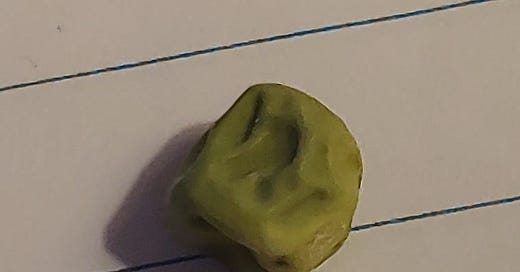This is a pea. It fell on the floor last weekend as I was organizing some seeds. Apparently I picked some pods last summer and tossed them in a brown paper bag to dry, unshelled. And there they sat for 8 months, until I shelled them and put them in a foil packet a few days ago. I was careless and dropped a few. And it seems I missed one, as it turned up under my office chair this morning.
It seems rather insignificant, this pea, all crinkled and desiccated and dead. The dog might have eaten it had she found it. Or it might have ended up in a dust pan on the way to the trash. No one would have noticed. But it didn’t. I saved it. This pea that looks like a pebble has been through a lot. The DNA locked inside of it is more complicated than the most complex human computer program, its surface more effective and versatile than the most sophisticated human chemical coating. It has been utterly neglected. Abused. But it patiently awaits its moment in the sun.
The insignificance is an illusion of circumstance. If this humble, crinkled starch ball were the last pea on earth, it could single-handedly repopulate the world with peas. Because it isn’t dead – it’s just waiting. Within this little pea is the knowledge and ability to transform a dead pebble into a swelling, living mass with roots and stems and leaves …with hundreds of peas attached. This dead little pebble is nothing less than a miraculous pea-making factory, whose only requirement is sun, soil and water.
Humans couldn’t make such a machine. We can disagree on what can make such a machine, but there is no question that we can’t. Not from scratch anyway. You could grind up this dead little pea into a thousand pieces and hand those pieces to the best scientists in the world, and they couldn’t put humpty dumpty back together again. Only stupid little dead peas know how to make peas.
We take so much for granted. This is why I am a gardener – to marvel at the magnificence of a dead little pea that I found on the office floor.






Love it. Profound, concise and true!